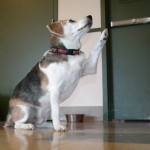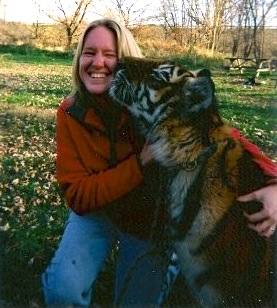“It’s my passion to bring people and pets together.”
Michelle Borchardt RVT, KPA-CTP generously shared her story with us. Michelle is the Behavior Technician and Trainer for UC Davis’ Behavior Service. Her main interest is expanding awareness of humane training methods for all animals, as well as low-stress restraint in the veterinary industry.
How long have you been training?
About 20 years. I was a veterinary technician when I started assisting in training dog in classes using mixed methods. Not long after, I started training animals (domestic species) for TV, movies and print. Eventually I progressed to training wild animals for the set, but also for stage shows and educational programs regarding conservation of endangered species.
What is your primary training or dog sport interest?
Currently I’m the Behavior Technician and Trainer for UC Davis’ Behavior Service. We apply science based training theories to change the conditioned emotional response of animals to triggers. It’s my passion to bring people and pets together. We see many animals with frustrated owners who don’t understand their pet isn’t misbehaving out of spite, dominance or snottiness. Animals are emotional beings that thrive with the right support – just like their owners. Fear is a terrible thing, which drives most aggressive behavior.
What prompted you to start learning about positive reinforcement training?
You can’t train a tiger to walk with you on a prong collar. In fact, punishment will just lead to the cat reciprocating. When I discovered that I could train a huge wild animal to sit, down, and stay reliably with food I felt horrible that I didn’t give my own dog the same respect. Animals aren’t widgets. They want to be active participants who are respected. Since then, I went on a philosophical journey which eventually led me to my current position at the Behavior Service. I have terrific mentors and see the benefits of force free positive training on a daily basis.
What changes did you see in your own dogs while you were crossing over?
I joined the Karen Pryor Academy. There I added new ideas to my toolbox. One of which was teaching my dog Pocket to fetch. I previously taught him by placing it in his mouth and telling him to stay. He HATED it. With clicker training, I clicked and treated him for approximations to the behavior and he LOVED it! See the video below. A great experience for us both. He’s 15 years old, but you’d never know it from his response.
This is Pocket learning to fetch. I apologize for the maniacal laughing, but you have no idea how much he HATED fetching before. https://youtu.be/87O3ZsxJcvs
What is the most important thing people should know about positive reinforcement training?
If you’ve ever tried clicker training you know there are times where your clicking is off. The good thing is that you get to try again, and the only down side is that the dog got a free treat! When I used a choke chain, I’m sure there were training sessions where my timing was off, but you can’t take back a correction.
What was the most difficult change for you?
Accepting that my former training may have had harmful side effects and not knowing any better. I felt guilty. Trainers who use punishment aren’t bad or stupid. They just need to make their own discoveries. Challenging your own “truth” is scary! Everyone learns in their own time and deserves respect. If not presented well, discussions can quickly turn into shouting matches, equal only to arguments about religion.
How did you overcome that difficulty?
I realize that dogs are Buddhists: they live in the now. I needed to do much the same. I can’t erase my history because it is part of who I am now. I do my best to inspire others to consider, try, or at explore Positive Reinforcement. I think that being open about my training past makes me more approachable to others because I understand both sides.
What’s the rest of your story?
I’m constantly learning and growing. Currently I’m working on my Registered Veterinary Technician Behavior Specialty and I graduated from the Karen Pryor Academy in June. I plan on doing presentations on low-stress handling of animals and science based training for technicians, trainers, and owners as often as possible.
Consider sharing your crossover journey. Click HERE to submit your story to the Crossover Trainer Blog.




